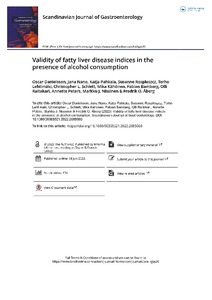Validity of fatty liver disease indices in the presence of alcohol consumption
Danielsson Oscar; Nano Jana; Pahkala Katja; Rospleszcz Susanne; Lehtimäki Terho; Schlett Christopher L.; Kähönen Mika; Bamberg Fabian; Raitakari Olli; Peters Annette; Nissinen Markku J.; Åberg Fredrik O.
https://urn.fi/URN:NBN:fi-fe2022091258411
Tiivistelmä
Background & aims: Non-alcoholic fatty liver disease (NAFLD) and alcohol-related liver disease frequently coexist. While several blood-based indices exist for the detection of NAFLD, few studies have examined how alcohol use possibly impacts their diagnostic performance. We analysed the effects of alcohol use on the performance of indices for detecting fatty liver disease (FLD).
Methods: We included participants from the Cardiovascular Risk in Young Finns Study (Finnish sample) and KORA study (German sample) who underwent abdominal ultrasound or magnetic resonance imaging, respectively, for detection of FLD and had serum analyses available for calculation of Fatty Liver Index (FLI), Hepatic Steatosis Index (HSI), Lipid Accumulation Product (LAP), and Dallas Steatosis Index (DSI). Alcohol use was estimated by questionnaires as mean daily consumption and binge drinking (Finnish sample only). Predictive performance for FLD was assessed according to alcohol consumption.
Results: The study included 1426 (Finnish sample) and 385 (German sample) individuals, of which 234 (16%) and 168 (44%) had FLD by imaging. When alcohol consumption was <50 g/day, all indices discriminated FLD with area under the receiver operating characteristics (AUROC) of 0.82-0.88. AUROCs were 0.61-0.66 among heavy drinkers (>50 g/day). AUROCs decreased to 0.74-0.80 in the highest binge-drinking category (>2 times/week). Alcohol use correlated with FLI and LAP (r-range 0.09-0.16, p-range <.001-.02) in both samples and with DSI (r = 0.13, p < .001) in the Finnish sample.
Conclusions: Indices perform well and comparably for detection of FLD with alcohol consumption <50 g/day and with different binge-drinking behaviour.
Kokoelmat
- Rinnakkaistallenteet [27094]
